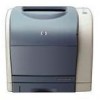HP 2500 HP PCL/PJL reference - Printer Job Language Technical Reference Manual - Page 219
Handling Unexpected Printer Responses, Programming Tips for Using PJL 11-25
 |
View all HP 2500 manuals
Add to My Manuals
Save this manual to your list of manuals |
Page 219 highlights
Note EN When the printer discards responses, the printer inserts the PJL unsolicited "printer to host data buffer overflow" message: CE CODE=10010 DISPLAY="00 READY" Refer to the "HP LaserJet 4 and 5 Family Comments" section in Appendix A under "Printer Status Readback" for the exact "printer to host buffer overflow" message sent by HP LaserJet 4 and 5 printer families. The PJL unsolicited "printer to host data buffer overflow" message is always inserted when the printer discards one or more responses, even if unsolicited status is turned off. I/O-switching printers set aside memory for each I/O interface. A response data buffer overflow on one I/O interface does not mean another I/O interface will also experience the overflow condition. To keep the printer's response data buffer from overflowing, applications should not send more than five queries without accepting the printer's response to those queries. The application should always send a PJL ECHO command to resynchronize with the printer status readback responses (i.e., get rid of any old responses). However, if the printer's response data buffer is full and the printer is discarding all future responses, then the host will receive a PJL unsolicited "printer to host data buffer overflow" message, but not the PJL ECHO response. Applications must be designed to handle situations where the printer's response data buffer overflows and the printer does not provide the expected response, but instead provides a PJL unsolicited "printer to host data buffer overflow" message. The application should resend all unanswered queries whenever the application receives a PJL unsolicited "printer to host data buffer overflow" message. Handling Unexpected Printer Responses Printer sharing devices, like the external printer sharing box or the MIO card inserted into the printer as shown in Figure 11-1, do not have sufficient information to allow the printer sharing device to properly route printer status readback responses to the host computer (the one running the application that queried the printer). In particular, unsolicited PJL status is difficult for the printer sharing Programming Tips for Using PJL 11-25















